At Farm Sanctuary, the impact a photo may have is immeasurable. Photos show us where we’ve been and how far we’ve come. They allow us to preserve memories of the individuals who are important to us and to share the details of their lives with others – and in our case, documenting the animals who call Farm Sanctuary home helps us shed light on important issues that are not always captured.
When we welcome an animal to one of our sanctuaries, it is often the first time that he or she has really been seen. Sadly, our residents come from an industry that hides them from view, instead promoting a sanitized image rather than the actual horrors these animals routinely experience. The majority of
the animals in the food industry pass through the system invisible and unnoticed.

But safe at sanctuary, everything changes; every one of our animal ambassadors is recognized as someone, not something. When we’re at the scene of a rescue, we always document the conditions the animals face, to validate their experiences and show the world the horrors that occur just out of view. And we photograph the animals through every stage of their recovery, to honor their journeys. These photos allow the animals to be seen and remembered as the valued friends we know them to be. They capture the transformations that supporters like you make possible, and help us change hearts and minds about how our relationships with farm animals should be.
We are deeply grateful for the volunteer photographers who help us bring the animals and their stories to the public. These caring individuals generously donate their time and talents to documenting various elements of Farm Sanctuary life – from guests interacting with our rescued residents at events to stunning portraits of our treasured animal friends. Their photographs offer a glimpse into a world where
animals and “humanimals” live in harmony, revealing just how fulfilling our lives can become when we choose compassion.
We asked a few of our longtime partners to share their experiences documenting Farm Sanctuary life, and their insights into the ways in which animal photography can inspire compassionate change.
And so, without further ado, here’s a snapshot of some of the incredible photographers who help us increase recognition of farm animals everywhere!
Derek Goodwin
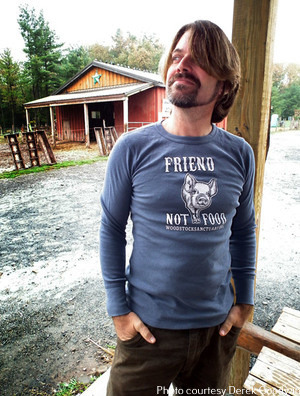
Derek is a photographer and artist who lives in Brooklyn, NY. He became
interested in photography as a child; as an adult, he followed his passion and earned a BFA in fine
art photography from the Rochester Institute of Technology. Derek’s photographs of farm animals have
been featured in books and magazines, brochures, websites, and television, all in the service of creating a more compassionate world.
Which photo or series of photos is most
meaningful to you?
This question is as easy to answer as “Who is your favorite animal?” Any time that [National Shelter Director] Susie Coston goes out with me and tells me the stories of the animals it moves me so deeply. There have been so many exquisite moments that made me laugh or cry or just feel at home. Most recently is probably the series I did of Julia pig and her babies not long after her rescue. How heartbreaking what she
went through, and how beautiful that she was saved and brought her babies into the world to live peaceful lives.
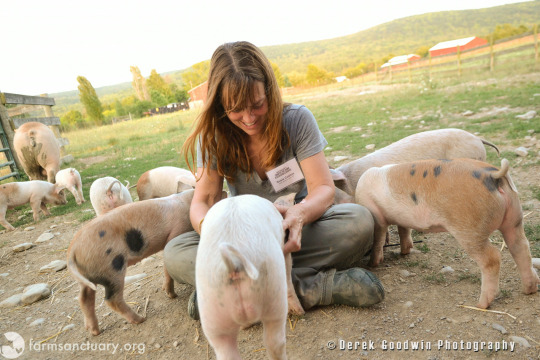
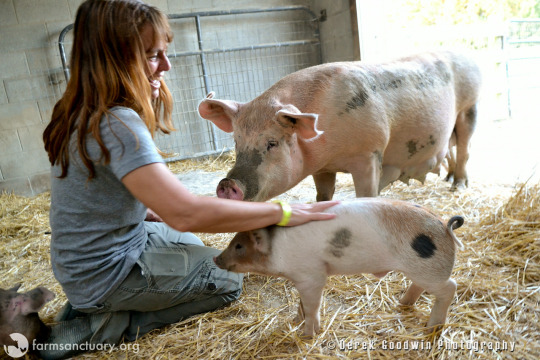
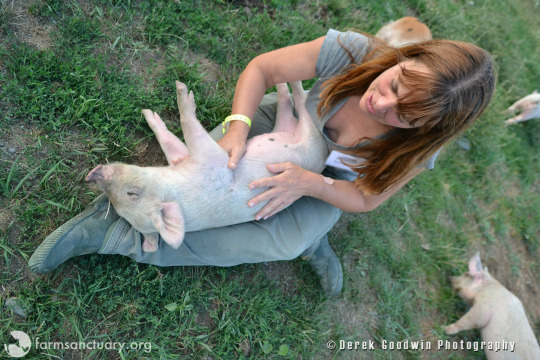

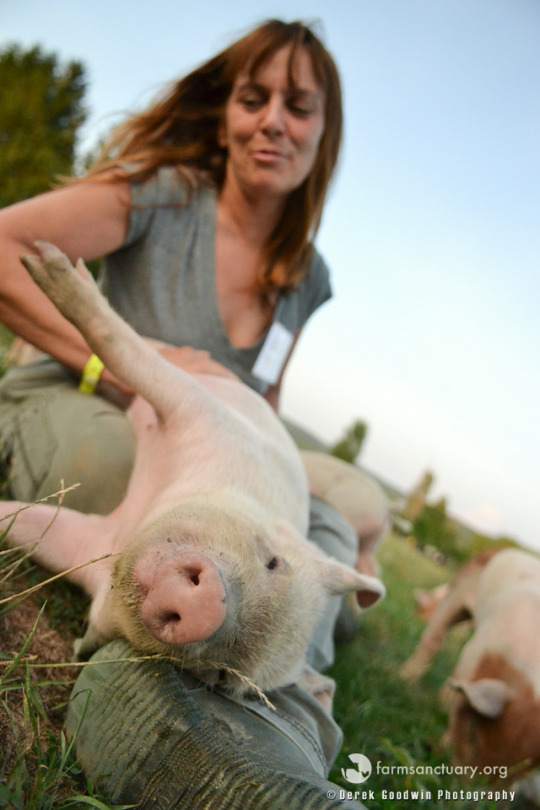
Describe something that happened while
photographing that really resonated with you.
I was doing some photos of Gene Baur with the animals and a storm system started moving in. We went inside the pig barn as it started to pour down rain, and thunder echoed over the landscape. The pigs who had been out enjoying the mud and clover began walking into the barn while Gene and I watched. One of the pigs stood by the doorway and watched while her friends shuffled in. The air was charged with the energy of the storm and all of us had hairs standing on end. It was a bonding moment for Gene and I and all of the pigs. A moment that still remains in my memory of oneness, where there was no separation between myself and nature and all of life.
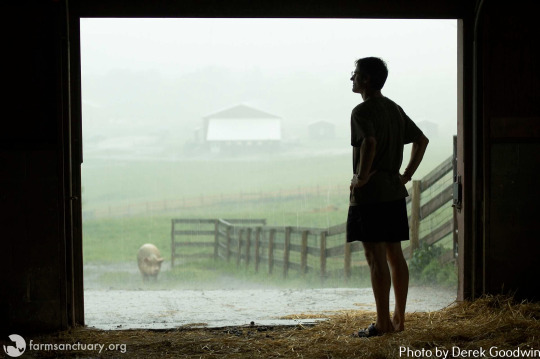
Do you have any tips for taking an animal’s photo?
Animals are people. Sit with them and tune in to their nature. Take photos from their
eye level, or lower. Be patient, and respectful. Remember you are there to
serve and help them, not the other way around.
What do you hope your audience will see in your photos?
I want to make connection between the animals and the people viewing the photos.
So there is no doubt these are sentient beings with personalities and the right
to exist. To transmit the deepest teaching of yoga, that the difference between
us and those we perceive as “other” is superficial. Within each being is the
spark of the divine, the manifestation of earth into form. I hope to transform
selfishness into selflessness.
Aaron Rosapepe
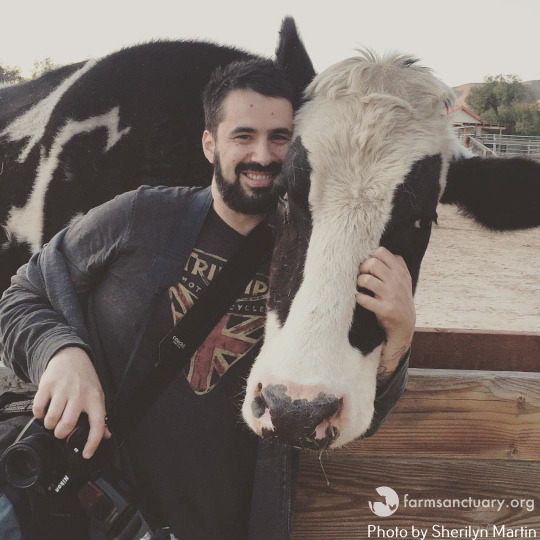
Aaron with William steer.
Aaron is an L.A.-based video editor and photographer who has been
vegan for the animals since 2005. You can find his work on Instagram
@theveganlens.
Which photo or series of photos is most meaningful to you?
My favorite photo is this shot of Macy. She was one of the first animals I bonded with at Farm Sanctuary and I watched her charm many other visitors as well. She has since passed on, but she was a
wonderful ambassador.
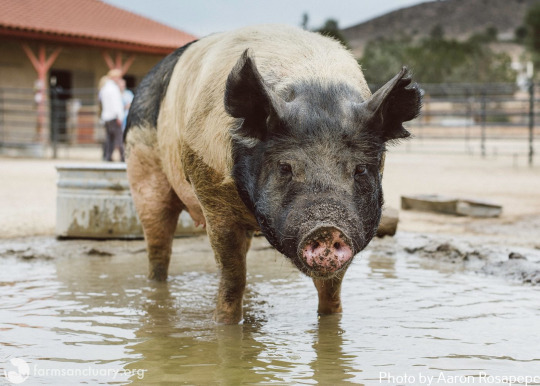
Describe something that happened while photographing that really resonated with you.
I’ve seen a lot of really beautiful moments as first-time guests begin to connect
with the animals at Farm Sanctuary, but the times I’ve been out there shooting
photographs with the staff have resonated with me the most. Everyone there is
so dedicated to the cause and so committed to the animals that I can’t help but
be inspired.
Do you have any tips for taking an animal’s photo?
Get a good night’s sleep beforehand and be prepared for maximum hustle (especially when goat glamour shots are on the list)! There is no way to control the circumstances, so just stay attentive, be
respectful, and you will ultimately capture some wonderful moments.
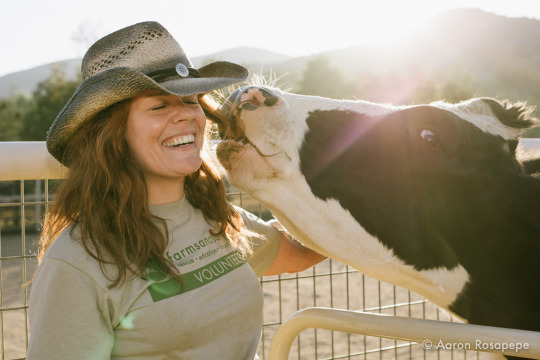
What do you hope your audience will see in your photos?
I hope that my photos will bring joy to those who already support the sanctuary
as well as inspire empathy and ultimately compassion in those who have not yet
come to view all animals as the intelligent, loving, and sentient beings that
they are.
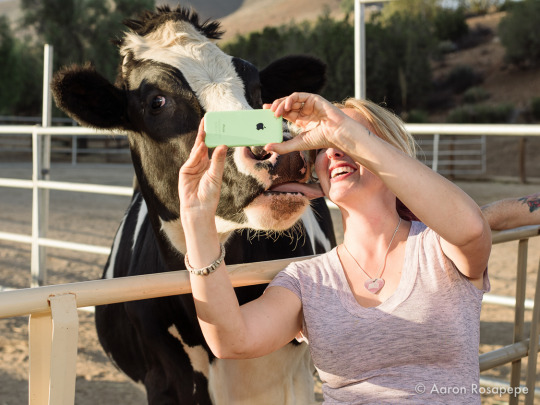
Vee Hertel

Vee Hertel is a diaristic documentary, fine art photographer based in Los Angeles. She received a BS in art with a
concentration in photography and a minor in Spanish at the College of Staten Island. She has exhibited her work in group exhibitions in NYC and L.A. She works as a portraitphotographer and volunteers for Farm Sanctuary.
Which photo or series of photos is your favorite or is most meaningful to you?
The most meaningful photos I’ve taken are of the animals interacting with humans
and with their other animal companions. It’s such a magical event to watch two
beings connect on a spiritual level.
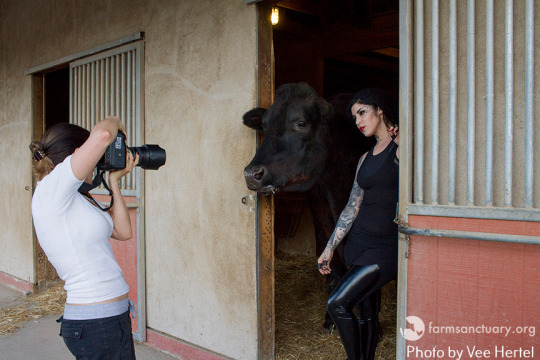
Behind the scenes with Kat von D and Bruno, for a photo shoot for Laika magazine.
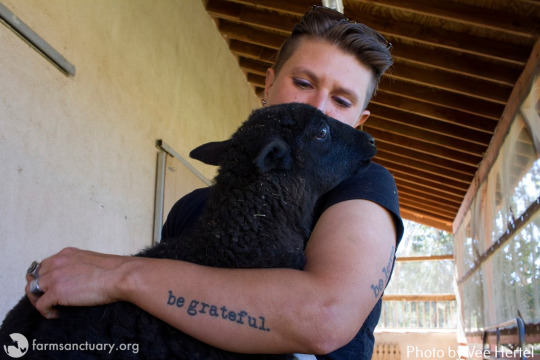
Facilities Coordinator Danielle Petrovich spends some quality time with Kelley lamb.
Do you have any tips for taking an animal’s photo?
It sure is difficult to capture a picture of an animal when they’re always moving! What I’ve learned is that you always have to keep your camera on you. That perfect moment will pass if you’re
not ready and aimed to take a photo. Look for the moments when they are being
the most candid, either with a person or when they’re fast asleep.
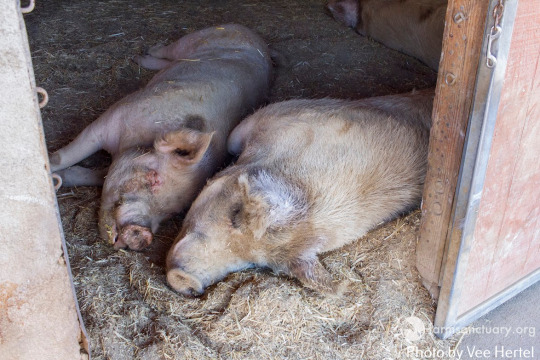
What do you hope your audience will see in your photos?
I aim to capture the pure and genuine connection that beings share with one another no matter the species, gender, race, or identity. We all embrace each other with love and acceptance!
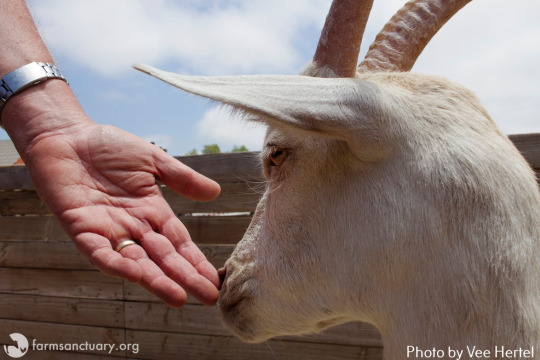
Vince goat checks out a human friend at our Southern California Shelter.
Joel Anderson
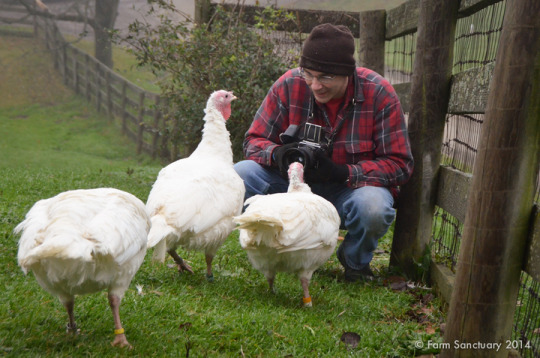
Joel Anderson uses his cameras to tell stories. Growing up on a Pennsylvania farm, he developed a
deep love of animals and rural life. Several years ago, he began photographing rescued animals at sanctuaries including Farm Sanctuary, and realized he could use the popularity of the images to raise funds for shelter
support. Ten percent of the sale of each vegan-friendly photograph is given directly to the shelter. After living in California and the Southwest, hereturned to Pennsylvania, where he lives with his wife and a family of
rescued animals.
Farm Sanctuary has been a magical experience every time I’ve gone up to photograph, and sharing the images with people has led to happy connections with folks who have seen my photographs at
art shows or online and either already support Farm Sanctuary or are now inspired to learn more about it.
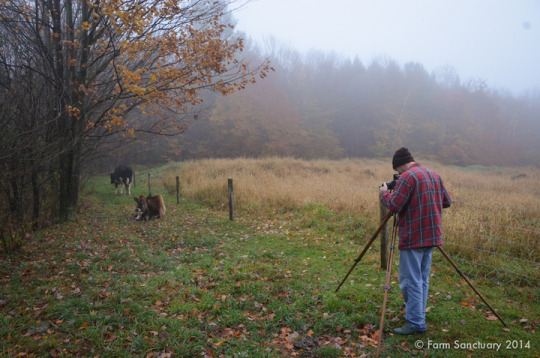
Joel on a photo shoot…
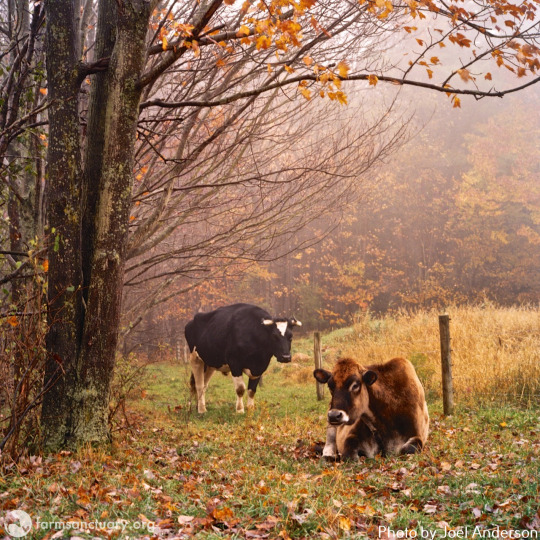
…and his subjects.
Some of my Farm Sanctuary photographs are on my website
for sale, and I’ve been able to make donations several times to the Farm
Sanctuary Emergency Rescue Fund with proceeds from sales of the photographs which
has been really gratifying. Susie and Luke [Hess, Farm Sanctuary’s Photo & Video Content Manager] have been very accommodating, and I hope to continue visiting and photographing, and honoring the work you all do.
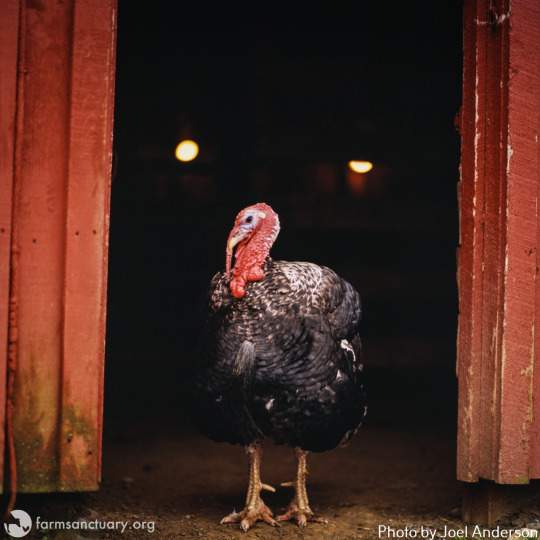
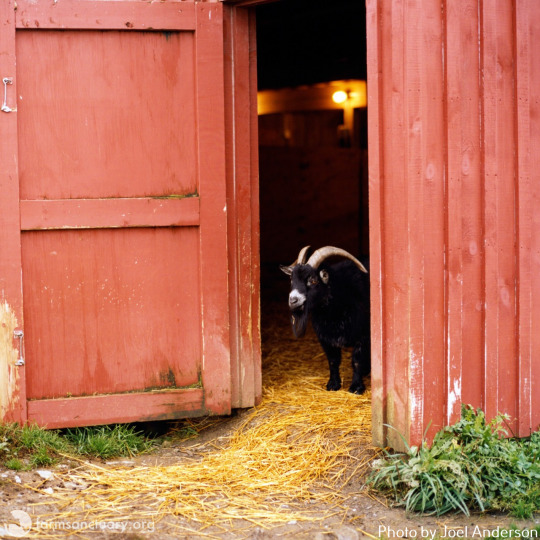
A percentage of profits from Joel’s photographs go directly toward helping animals like Wilson, above.
Which photo or series of photos is your favorite or is most meaningful to you?
Probably my favorite photograph is of Ogar the pig because he seemed to enjoy posing for his portrait so much. We had a nice little moment.
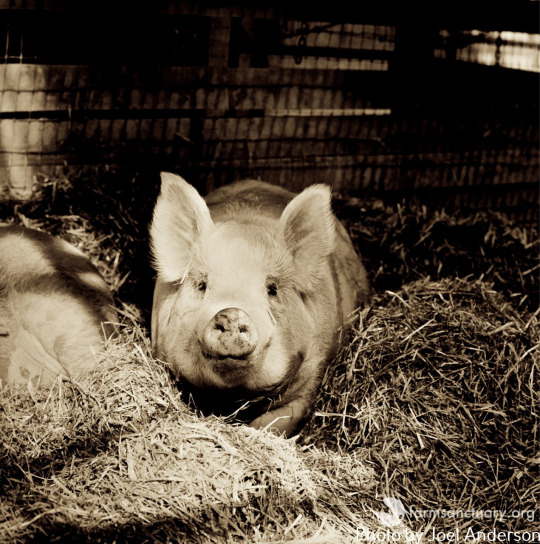
Do you have any tips for taking an animal’s photo?
My biggest tip for photographing animals is more about the photographer and less about the cameras (I used a medium format film camera for Ogar’s portrait and most of the other sanctuary
photos I’ve taken) — treat the animal just like you would a person when photographing them, not as an object. Give it a few minutes and establish a rapport, and get a sense of the animal as an individual. They’re not objects, although too many photographers treat them that way.
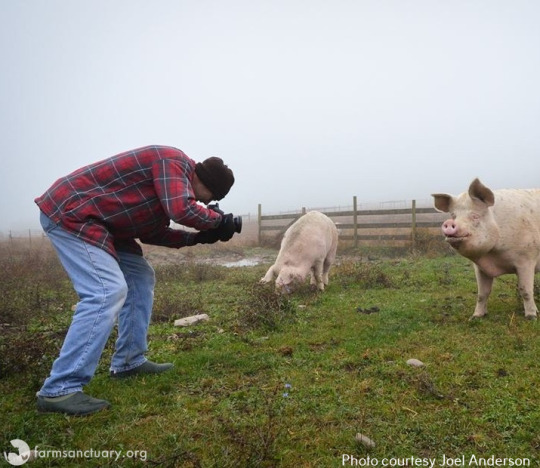
Joel gets down on a personal level with Felicia and Calypso pigs.
Lesley Marino
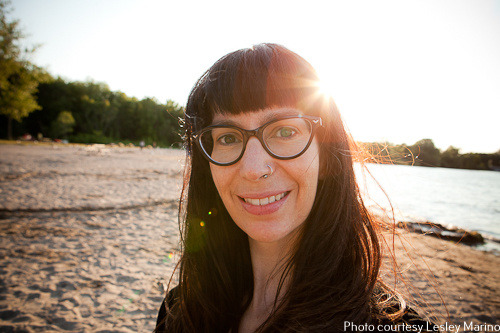
Lesley Marino loves capturing the unique personalities of, and relationships between,
people and animals. She has been a volunteer photographer for Farm Sanctuary
since 2007, mainly shooting events, including conferences and galas (She captured this incredible moment among others at last year’s Farm Sanctuary Gala.). Lesley especially
loves spending time with the animals at the farm. Lesley lives in Toronto,
Canada, with her husband and son.
For me, the most meaningful photo I’ve taken at Farm Sanctuary is one of my son, Elliot, when he was two-and-a-half years old, with one of the donkeys. He got right up close to their face and
said, “I can see me in his eyes!” I know he literally meant that he could see his reflection in the donkey’s eyes, but to me that statement has so much more meaning. The way we treat animals is truly a reflection of our own ability to show love and compassion to all beings. I hope someone looking at my photos
can see themselves reflected in the eyes of an animal and see them as individuals capable of experiencing the same range of emotions that we do — joy, love, happiness, fear, trepidation, sadness — and choose a path based on compassion.
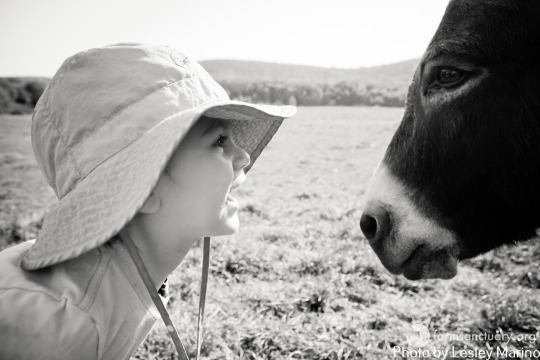
Frank Noelker
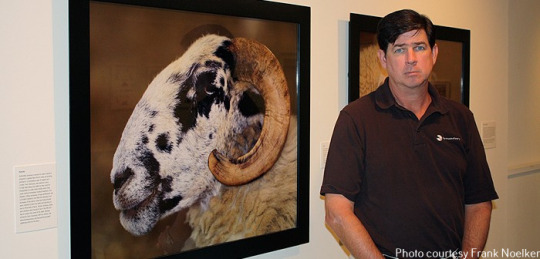
Frank Noelker is an American fine art photographer. Currently an associate professor of art at the University of Connecticut, he received a B.A.degree from Webster University and an M.F.A. from the Rhode Island
School of Design. His photographs have been widely exhibited and are included in the permanent collections of a number of museums. Noelker is represented by Howard Yezerski Gallery, Boston, MA, and Galerie St. Etienne, New York, NY. His work has recently been published in the book Captive Beauty: Photographs by
Frank Noelker.
I think the most important thing to have when photographing animals is patience. Since we cannot communicate as easily with nonhuman animals as we can with our fellow humans we need to be extremely
patient in order to get the images we want. The burden of communication is so often put on the non-human animals — one must be careful to not slip into the arrogant trap of trying to get them to do what you want.
It’s best to take your time and let the goats or sheep or whoever get used to you. When things go really well you slip into a kind of “zone” where time no longer is of importance and the beautiful feeling of being in such a special place takes over. If you prepare, and you’re patient, eventually they will give you the photographs you want.
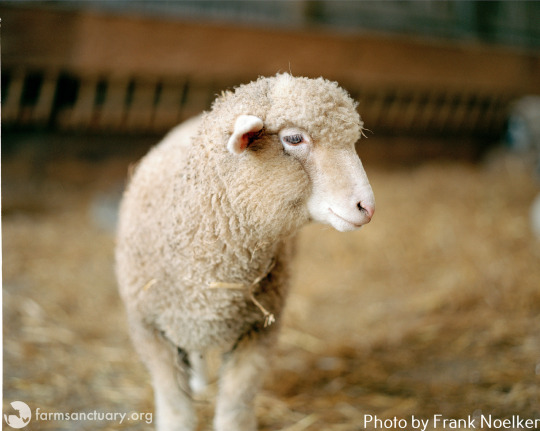
Frank earns Mandy’s trust for this sweet photo.
These portraits and other projects I’ve completed all reflect the complexities of our relationships to animals. Many people believe that animals operate essentially by instinct, possessing limited emotion or intelligence, and they seem to be afraid that anything else could be true. I believe we have lost a great deal because of our reluctance to embrace the continuity between animals and ourselves. My work is, on one level, an attempt to bridge that void.
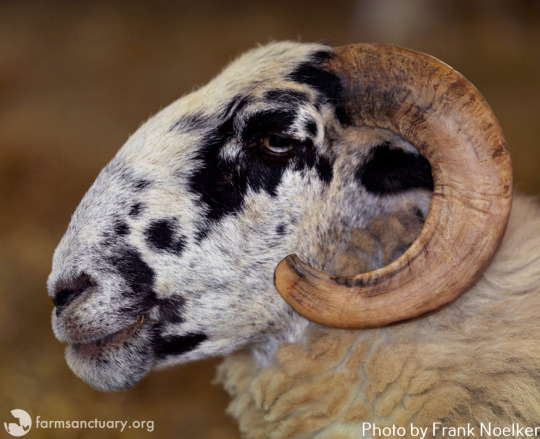
The magnificent Ramsey.
Isa Leshko

Isa Leshko is an artist whose work focuses on themes relating to animal rights,
aging, and mortality. She has exhibited her work widely in the U.S., has prints in numerous private and public collections, and has received severalfellowships for her work. Her first book based on her acclaimed Elderly Animals project will be published by University of Chicago Press in 2018. To be notified when it is released, you can contact her here. Isa currently lives in Salem, MA, with her domestic partner, Matt Kleiderman,
and their cat Alfred.
Unlike the previous six photographers, Isa is not technically a volunteer, as her work with our rescued residents is part of a personal fine art project involving intimate portraits of elderly farm animals. However, she graciously licenses images to Farm Sanctuary free of charge, and will continue to bring our rescued residents’ stories to the mainstream through an upcoming book project (also featuring Gene and Susie, who are co-writing an essay for the book).
Tell us about your photo series. What do you hope your audience will see in your photos?
Over the last several years, I have visited sanctuaries across the country to create intimate photographic portraits of elderly farm animals. I began this series shortly after caring for my mom, who had Alzheimer’s disease. The experience had a profound effect on me and forced me to confront my own mortality. I am
terrified of growing old, and I started photographing geriatric animals in order to take an unflinching look at this fear. After visiting Farm Sanctuary, though, this project became more than a therapeutic exercise for me. It became important that I use my work to advocate on behalf of farm animals.
As readers of this blog know, farm animals usually don’t have the luxury of growing old; most die before they are six months old. As a result, my images present these animals very differently from how people generally envision them. As beings aware of our own mortality, we all hope to live long enough to reach old age in comfort. By depicting the beauty and dignity of farm animals in their senior years, I ask viewers to
reflect upon what is lost when these animals are slaughtered at a young age.
With this work, I strive to depict the unique personality of each animal I photograph in order to illustrate that farm animals are emotional sentient beings. Many of the animals in my project were rescued from horrific situations. They adore the sanctuary workers who care for them but are wary of strangers. Gaining their trust can take considerable time but is essential to my process.
I spend several quiet hours with each animal I photograph. Before taking any pictures, I often lie on the ground next to the animal to help him or her become comfortable with me. While photographing, I remain on the ground at eye level with the animal. I draw upon formal portraiture techniques while working because I want viewers to relate to the animals in my images as peers.
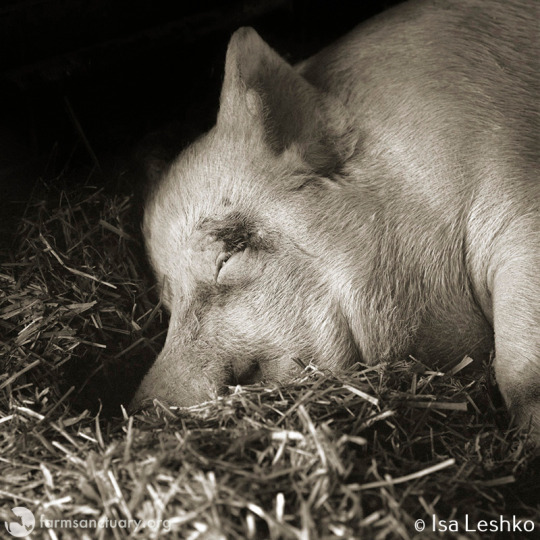
Isa gets to know animals like Teresa intimately, building rapport before photographing them.
For this series I have also photographed elderly companion animals. I juxtapose these images with my farm
animal portraits in order to exemplify the similarities among these animals. In doing so, I invite viewers to reflect upon why farm animals are treated so differently from dogs and cats.
What have you learned while working on this project?
During my first visit to Farm Sanctuary, I was surprised to see how affectionate farm animals can be. I was floored the first time I saw a turkey act like a lap cat! I confess I have a massive weakness for female turkeys. I love everything about them: their soft heads, the sweet trills they make, the way their white feathers catch the sunlight. The first turkey I fell in love with was Ash, who lived in the Orland sanctuary.

I was especially drawn to her because her eyes conveyed so much strength and sensitivity. During that trip, I had planned to spend time with other animals at the sanctuary. But I couldn’t tear myself away
from Ash. I remember spending hours lying next to her just watching her sleep. I was so smitten that as soon as I returned home, I adopted Ash through Farm Sanctuary’s Adopt a Farm Animal Program. I loved receiving the adorable adoption certificate with her picture. Ten months later, she passed away and I was so sad.
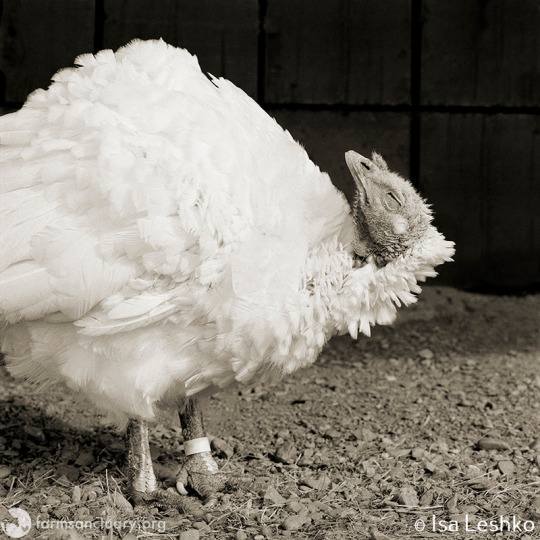
That’s actually the hardest aspect of my work. Most of the animals I photograph pass away within months after I meet them. In several instances, an animal has died the day after I photographed her. I spend
several days with each animal I photograph and then I spend many hours thinking about them as I edit and print my images. These animals become quite dear to me and each loss is painful. Grief initially inspired this project and it also has become an inherent byproduct of making this work.
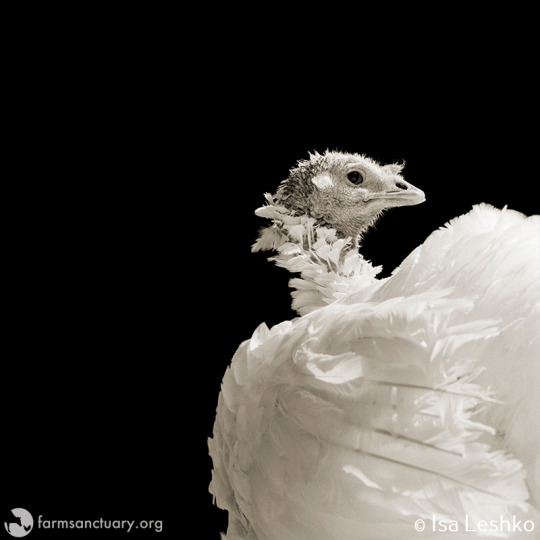
Describe something that happened while photographing that really resonated with you.
One of my favorite moments happened in May of this year. I visited Orland in order
to photograph Melvin, a senior angora goat who resides with the domestic sheep herd at the sanctuary.
Spending time with Melvin was quite a treat because he is the most affectionate goat I have ever met. Whenever a sanctuary staff member approaches his enclosure, he puts his front paws on the gate and peeks his head through the railing. By the second day of my visit, Melvin began doing this when he saw me enter his barn. I felt so honored! That alone was special, but the most moving moment from that trip
involved the sheep who reside with Melvin.
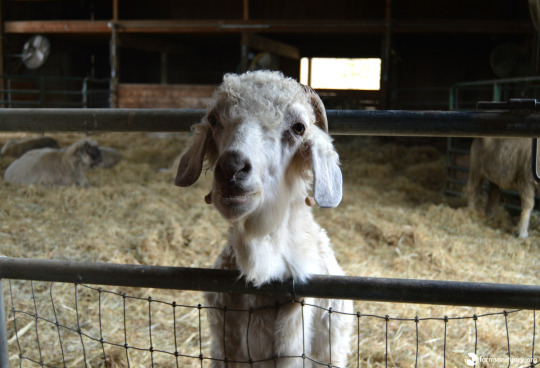
Melvin’s signature greeting; photo taken by Orland Shelter Manager Kate Powell.
Sheep tend to be a bit shy at first when they meet me. Whenever I enter a sheep barn for the first time, the animals immediately disperse outdoors. I jokingly say to the animals as they leave: “Was it something I said, guys?” I don’t take it personally, though. I am shy around strangers, too, when I first meet them.
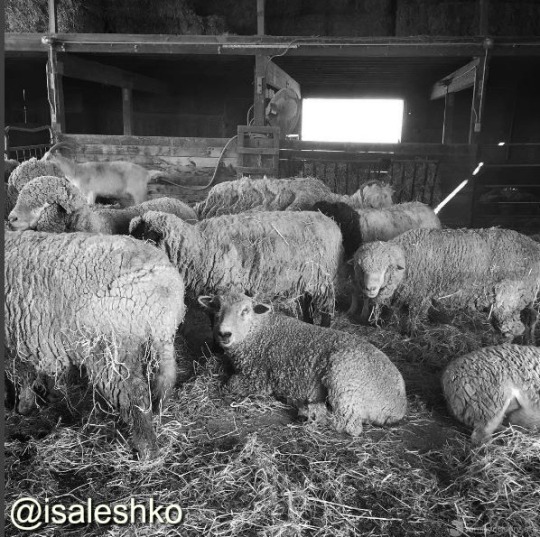
The Santa Cruz sheep who resided in Orland were especially challenging to photograph because
they had been once feral. They were so majestic looking, though! I knew I wanted to photograph them the moment I saw them. It took several days of slowly approaching these sheep and lying next to them in order to develop a rapport with them. Eventually I was able to create a few beautiful portraits, but I did
not feel as though I had developed a close connection with any of them.
Fast forward to May of this year, when I was photographing dear Melvin. Toward the end of the second day of my visit, I suddenly felt hot breath on my arm. I turned and discovered one of the sheep standing next to me. He had approached me! He licked my sweaty arm and gently bumped his head against my cheek. The rest of the herd circled around us and we stayed that way for several minutes. It was magical.
Derek, Aaron, Vee, Joel, Lesley, Frank, and Isa all have a brilliant eye for sharing these ambassadors for their species with the world, changing hearts and minds about our relationships with farm animals everywhere. We are so grateful for the time and talents they lend getting to know our residents on a personal level and communicating the qualities that make them so unique, special, and worthy of our care and compassion.
Enviroshop is maintained by dedicated NetSys Interactive Inc. owners & employees who generously contribute their time to maintenance & editing, web design, custom programming, & website hosting for Enviroshop.
